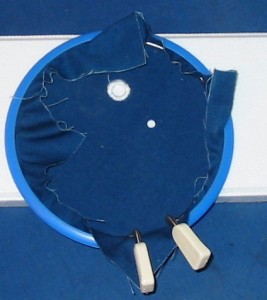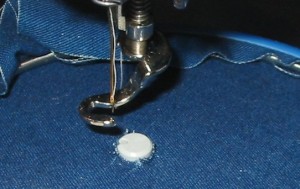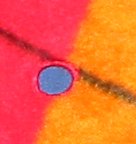Genähte Ösen sind ja immer so eine Sache… mit einer Stickmaschine kein Problem, aber ohne? Handgenäht werden sie bei mir ja leider nicht so schön. Aber es gibt ja Lochstickeinrichtungen. Und seit etwa zwei Jahren liegt so eine in meinem Schrank. Nur zum Ausprobieren bin ich irgendwie nicht gekommen.
Aber da liegt noch eine Kapuzenjacke aus Fleece, die braucht Ösen und Metallösen in Fleece funktioniert ja auch nicht immer so gut. Also endlich eine Gelegenheit, das Lochstickset auszuprobieren….
Sewn eyelets are not easy. An embroiderymachine does it easily, but with a simple sewing machine? Handsewing is great, but if I’m sewing them they are not so beautifull. But there are eyelet sets for sewing machines. And I even own one for about two years. But since I’n having it, I had no reason to use it.
Then there is this hooded fleece vest. Metall eyelets in fleece do not always work so well. So… finally a good possibility to test my eyelet set.
 Für den Test nehme ich erst mal einen mittelfesten, glatten Baumwollstoff. In dunkelblau mit weißem Nähgarn umnäht.
Für den Test nehme ich erst mal einen mittelfesten, glatten Baumwollstoff. In dunkelblau mit weißem Nähgarn umnäht.
Nachdem die erste Öse gleich gut funktioniert hat, teste ich eine zweite… und mache auch Photos.
Schritt eins ist, den Stoff in einen Stickrahmen zu spannen.
Dann wird ein Loch gestanzt (im Bild das rechte Loch), das Loch sollte kleiner sein, als die fertige Öse. Am besten geht das mit einem Locheisen, das Bernina Lochmuster Set bringt einen Satz Locheisen mit und ein Stück Holz zum unterlegen beim Stanzen
For my test I’m using a simple stabile cotton in blue. And a white sewing thread.
The first experiment worked perfectely well, so I’ve been taking pics while I did a second one.
Step one is framing the fabric in an embroidery hoop.
Then you need a hole. My Bernina Eyelet Set includes the tool in different sizes, also a piece of wood to underlay.
 Danach kommt der Stoff auch schon unter die Maschine.
Danach kommt der Stoff auch schon unter die Maschine.
Man erkennt den offenen Fuß und eine runde, grau Scheibe aus Plastik, die auf der Stichplatte befestigt werden kann.
Der Fuß verrät schon, daß Freihand arbeiten ohne Transporteur angesagt ist.
Und das Loch wird über den Plastikdeckel geschoben.
Then I can start working on the machine.
There is an open foot and a round, grey button, that is attached to the plate. The foot shows, that the feed dogs have to be lowerd or covered (depending on the machine.)
The grey plastic thing is to place the fabric hole on it.
 Die Stichbreite wird auf Zickzack gestellt, auf einen schmalen Zickzack, etwa 1,5-2. Wie schmal möglich ist, hängt auch vom Stoff ab. Ist es zu schmal, reißt der Stoff aus und man hat eine Reihe Stiche und einen Stoff mit Loch. *g*
Die Stichbreite wird auf Zickzack gestellt, auf einen schmalen Zickzack, etwa 1,5-2. Wie schmal möglich ist, hängt auch vom Stoff ab. Ist es zu schmal, reißt der Stoff aus und man hat eine Reihe Stiche und einen Stoff mit Loch. *g*
Dann losnähen und den Stoff schön drehen, das geht wirklich ganz einfach und intuitiv. (Ich war überrascht wie einfach es gleichmäßig wird.)
You set your machine to a zigzag stitch, a rather narrow one, 1,5-2. How large or narrow depends on the fabric, if it is to narrow the stitches will not be stabile enough in the fabric. In that case you’ll result with some pretty stitches all alone and a pretty loose hole…*g*
Then start sewing. And turn the fabric with the hoop. It’s really easy to make regular stitches, I was really surprised how easy and intuitively it worked and produced even stitches.
 Diese erste Reihe stabilisiert das Loch, jetzt kommt noch eine zweite, mit einem etwas breiteren Zickzackstich, die die Öse kompletiert.
Diese erste Reihe stabilisiert das Loch, jetzt kommt noch eine zweite, mit einem etwas breiteren Zickzackstich, die die Öse kompletiert.
Das Bild zeigt das Ergebnis mit einer Universalnadel und einem billigen Nähgarn. (Reste aus vergangenen Tagen, mit gutem Grund nur zum Testen aufgebraucht…….) noch Mit einer Sticknadel und Stickgarn wird es sicher noch etwas schöner.
This first row of stitching stabilizes the cut edge. Now comes a second row to make a nice eyelet. This second row of zigzag should be a little larger than the forst one.
The picture shows the result with a simple universal needle and some cheap sewing thread (using up restovers from long ago days for testing), embroidery thread and a fitting needle should bring an even nicer result.
Doch das war nur der Test… eigentlich soll die Öse ja in Fleece…
 Und der ist etwas dehnbar. Aber… auch das funktionierte prima, wie das Bild zeigt. (Okay, mit Macro wäre es besser zu erkennen, aber an dem Tag wollte meine Camera das mal wieder nicht…)
Und der ist etwas dehnbar. Aber… auch das funktionierte prima, wie das Bild zeigt. (Okay, mit Macro wäre es besser zu erkennen, aber an dem Tag wollte meine Camera das mal wieder nicht…)
Dafür habe ich Maschinenstickgarn genommen, eine Jerseysticknadel von Organ und der Zickzackstich mußte etwas breiter sein, da sich der Fleece unter den Stichen etwas zusammenzieht.
Das Führen des Stoffes war etwas schwieriger, erfordert mehr Gefühl, sonst wird das Loch etwas „eierig“. Ich denke aber, mit etwas Stickfvlies darunter oder Soluvlies sollte das einfacher machen. Ich hatte nur keine Lust, die Jacke zuerst zu waschen…
But this was only the test… what I wanted to sew was eyelets in Fleece. And Fleece is thicker and stretchy.
But to my surprise even that worked great as the picture shows. (Okay, using macro settings of my camera would have resulted in better pics, but my camera doesn’t always macro and that day it didn’t….)
This time I’ve used embroidery thread and a special jersey-embroidery needle from Organ. Also the zigzag setting was put to a larger stitch, because the Fleece is stretchy and will contract a bit after beeing removed from the hoop.
Guiding the fabric was a bit more complicated than on the non stretch cotton if you don’twant an oval eyelet. I think stabilizer or water soluble stabilizer (Soluvlies) should make that easier. But I didn’t feel like washing the garment before wearing it…
Das Lochstickset war jedenfalls eine ganz prima Anschaffung!
Whatever, the embroidery eyelet set was a great buy!
